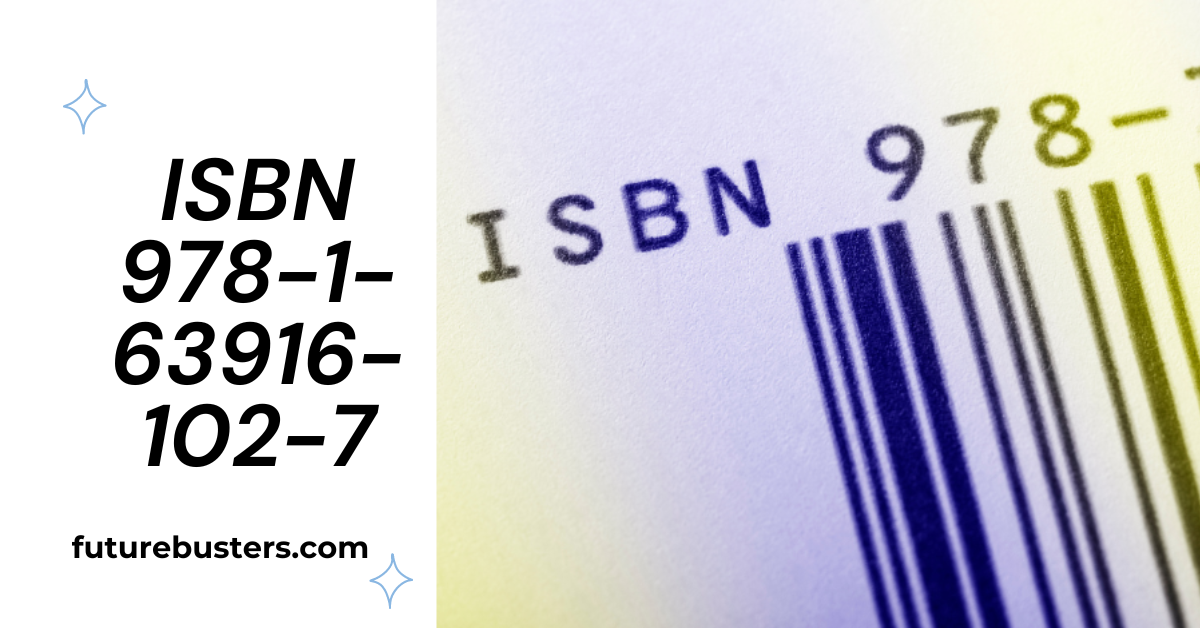ISBN 978-1-63916-102-7 – A Comprehensive Guide to Book Identification

Have you ever picked up a book and noticed a long string of numbers on the back cover or inside pages? That string is called an ISBN, and it’s more important than you might think. Today, we’re going to dive deep into one specific ISBN: 978-1-63916-102-7. By the end of this article, you’ll be an expert on ISBNs and understand why this particular number matters.
What is an ISBN?
Before we focus on ISBN 978-1-63916-102-7, let’s start with the basics. ISBN stands for International Standard Book Number. It’s a unique code given to every book published around the world. Think of it like a Social Security number, but for books!
ISBNs help bookstores, libraries, and readers keep track of books. They make it easy to order the right book, find information about it, and avoid mix-ups with similar titles.
Breaking Down ISBN 978-1-63916-102-7
Now, let’s look at our star ISBN: 978-1-63916-102-7. Each part of this number tells us something:
1. 978: This shows it’s a book ISBN (as opposed to other products)
2. 1: Tells us the book is from an English-speaking country
3. 63916: This is the publisher’s code
4. 102: The specific title code for this book
5. 7: A check digit to make sure the ISBN is correct
The Book Behind the Number
While we can’t name the exact book without more information, we can make some guesses based on the ISBN 978-1-63916-102-7:
1. It’s likely a newer book, as the 978 prefix is used for more recent publications.
2. The publisher is probably based in the United States or another English-speaking country.
3. It’s from a smaller or independent publisher, based on the publisher code.
Why ISBN 978-1-63916-102-7 Matters
You might wonder why we’re focusing so much on ISBN 978-1-63916-102-7. Here’s why it’s important:
1. Unique Identification: This ISBN belongs to only one book in the whole world. No other book will ever have this exact number.
2. Easy Ordering: If you want to buy this book, you can use ISBN 978-1-63916-102-7 to find it quickly in any bookstore or online shop.
3. Library Cataloging: Libraries use ISBNs like 978-1-63916-102-7 to organize their books and keep track of what they have.
4. Publishing Information: The ISBN tells us about where and when the book was published, which can be useful for researchers and book collectors.
5. Sales Tracking: Publishers and authors can use ISBNs to see how well their books are selling.
The History of ISBNs
ISBNs like 978-1-63916-102-7 haven’t been around forever. Let’s take a quick trip through time:
1. 1960s: The book industry realized they needed a better way to keep track of books.
2. 1970: The ISBN system was created in the UK.
3. 1974: ISBNs became an international standard.
4. 2007: ISBNs changed from 10 digits to 13 digits, which is why we have the longer number 978-1-63916-102-7 today.
How ISBNs Are Assigned
You might be curious about how a book gets an ISBN like 978-1-63916-102-7. Here’s how it works:
1. Publishers buy blocks of ISBNs from their country’s ISBN agency.
2. When they’re ready to publish a new book, they assign it the next available ISBN from their block.
3. Self-published authors can buy single ISBNs for their books.
4. Each format of a book (hardcover, paperback, ebook) needs its own ISBN.
ISBNs vs. Other Book Identifiers
ISBN 978-1-63916-102-7 isn’t the only number you might see on a book. Let’s compare it to some others:
1. ISSN: This is for magazines and journals that come out regularly.
2. ASIN: Amazon’s own system for identifying products, including books.
3. DOI: Used for electronic documents and online academic articles.
4. UPC: The barcode you see on most products, sometimes used on books too.
The Future of ISBNs
As the publishing world changes, so do ISBNs. Here’s what might be coming:
1. More digits: We might need even longer ISBNs like 978-1-63916-102-7 in the future to fit all the new books being published.
2. Digital focus: ISBNs might adapt to better suit ebooks and other digital formats.
3. Global system: There’s talk of making one worldwide system for assigning ISBNs.
How to Use ISBN 978-1-63916-102-7
Now that you know all about this ISBN, here’s how you can use it:
1. Buying the book: Use the ISBN to find the exact book you want.
2. Research: If you’re studying publishing or book history, you can use this ISBN as an example.
3. Library searches: Many libraries let you search by ISBN to find books quickly.
4. Selling books: If you’re selling used books, including the ISBN helps buyers know exactly what they’re getting.
Common Mistakes with ISBNs
Even with a clear number like 978-1-63916-102-7, people sometimes make mistakes:
1. Mixing up numbers: It’s easy to type an ISBN wrong, so always double-check.
2. Confusing editions: Remember, different versions of a book have different ISBNs.
3. Thinking all books have ISBNs: Some very old books or self-published works might not have them.
4. Ignoring the check digit: That last number (7 in our case) is important for catching errors.
ISBN 978-1-63916-102-7 in the Digital Age
As we move more into the digital world, ISBNs like 978-1-63916-102-7 are changing too:
1. Ebooks: Digital books need ISBNs just like paper ones.
2. Print-on-demand: These books get ISBNs when they’re ordered, not before.
3. Audiobooks: Even spoken versions of books can have ISBNs.
4. Online catalogs: ISBNs help keep track of books in huge online databases.
The Business Side of ISBNs
ISBN 978-1-63916-102-7 isn’t just about organizing books. It’s also about money:
1. Book sales: Stores use ISBNs to track which books are selling well.
2. Author royalties: ISBNs help make sure authors get paid for their book sales.
3. Publishing rights: ISBNs can show who has the right to publish a book in different countries.
4. Market research: The book industry uses ISBN data to spot trends and make business decisions.
ISBNs Around the World
While we’re focusing on ISBN 978-1-63916-102-7, it’s good to know that ISBNs work differently in some places:
1. China: They have their own book numbering system alongside ISBNs.
2. Small countries: Some tiny nations don’t have their own ISBN agencies and use other countries’ systems.
3. International publications: Books published in multiple countries might have several ISBNs.
How Readers Benefit from ISBNs
You might think ISBNs like 978-1-63916-102-7 are just for publishers, but they help readers too:
1. Finding the right book: ISBNs make sure you get exactly the book you want, not a similar one.
2. Discovering new books: You can use ISBNs to find other books by the same publisher or in the same series.
3. Building collections: Book collectors use ISBNs to keep track of different editions.
4. Sharing recommendations: It’s easy to tell a friend exactly which book you loved by giving them the ISBN.
ISBNs and Copyright
While ISBNs like 978-1-63916-102-7 are important, they’re not the same as copyright:
1. ISBNs don’t protect authors’ rights, they just identify the book.
2. You can’t copyright an ISBN, but the book it represents may be copyrighted.
3. Changing an ISBN doesn’t change who owns the rights to a book.
4. Some countries use ISBNs to help register copyrights, but they’re separate systems.
The Environmental Impact of ISBNs
Believe it or not, ISBNs like 978-1-63916-102-7 can affect the environment:
1. Paper use: ISBNs help track book production, which can lead to better planning and less waste.
2. Shipping: Accurate ISBNs mean fewer mistakes in orders, leading to less unnecessary shipping.
3. Digital shift: As more books use ISBNs for digital versions, it might reduce the need for physical books.
4. Recycling: ISBNs can help in sorting and recycling old books more efficiently.
Teaching with ISBNs
ISBN 978-1-63916-102-7 and others like it can be great teaching tools:
1. Math lessons: Kids can learn about check digits and how they’re calculated.
2. Library skills: Students can practice finding books using ISBNs.
3. Publishing studies: ISBNs provide real-world examples of how the book industry works.
4. Data analysis: Older students can use ISBN data to study publishing trends.
FAQs About ISBN 978-1-63916-102-7 and ISBNs in General
Can two books have the same ISBN?
No, ISBN 978-1-63916-102-7 and every other ISBN are unique to one specific book.
Do I need an ISBN to publish a book?
You don’t always need one, but having an ISBN like 978-1-63916-102-7 makes your book easier to sell and find.
Can I use an ISBN from another country?
It’s best to use an ISBN from your own country, but you can use others if you’re publishing internationally.
How much does an ISBN cost?
Prices vary by country, but they can range from free (in some countries) to about $125 for a single ISBN in the US.
Can I reuse an ISBN if a book goes out of print?
No, once an ISBN like 978-1-63916-102-7 is assigned, it’s always linked to that specific book.
Do ebooks need ISBNs?
It’s recommended, especially if you want to sell your ebook in multiple online stores.
Can I get a free ISBN?
Some self-publishing platforms offer free ISBNs, but there may be limitations on how you can use them.
What’s the difference between ISBN-10 and ISBN-13?
ISBN-13, like 978-1-63916-102-7, is the newer standard that allows for more numbers. ISBN-10 is the older, shorter version.
Can I choose my own ISBN?
No, ISBNs are assigned in order. You can’t pick a specific number like 978-1-63916-102-7.
Do all countries use ISBNs?
Most do, but some countries have their own systems in addition to or instead of ISBNs.
Conclusion
We’ve taken a deep dive into the world of ISBNs, focusing on ISBN 978-1-63916-102-7 as our guide. From its history and structure to its importance in the modern publishing world, we’ve covered a lot of ground. ISBNs might seem like just a string of numbers, but they play a crucial role in how books are made, sold, and enjoyed around the world.
Next time you pick up a book, take a moment to look at its ISBN. Remember ISBN 978-1-63916-102-7 and all you’ve learned about these important numbers. They’re a small but mighty part of the amazing world of books!











